Electronic fuel injection is a great means of delivering fuel to an engine. With multiport systems, each cylinder receives its own dose of fuel, and with sequential controls, the air/fuel ratio for each cylinder can be quickly changed to keep in step with changes in engine load. EFI also improves cold starting, reduces emissions, improves fuel economy and performance.
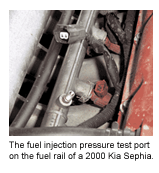 But sometimes things go amiss.
But sometimes things go amiss.
Fuel injection problems encompass everything from hard starting, stalling and misfiring to hesitation, surging and no-starts. Dirty injectors, for example, will restrict the amount of fuel that’s sprayed into the engine with every pulse of the injector resulting in a leaner-than-normal fuel mixture. This, in turn, can cause lean misfire, hesitation, poor performance and an increase in hydrocarbon (HC) emissions.
EFI Problems Defined
Because EFI is part of the powertrain control module’s feedback control loop, problems with the coolant sensor or oxygen sensor also can affect fuel delivery. A coolant sensor that always reads cold will prevent the engine from going into closed loop resulting in a rich fuel mixture and poor fuel economy. A dead oxygen sensor can have the same effect. So too, can a contaminated or sluggish O2 sensor.
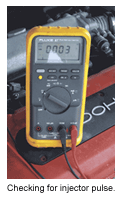 The PCM also relies on inputs from the throttle position sensor, airflow sensor (if one is used), manifold absolute pressure (MAP) sensor and intake air temperature sensors to adjust the fuel mixture. Most sequential injection systems use the signal from the camshaft or crankshaft position sensor to trigger and sync the injector pulses. Problems in any of these sensor circuits also can affect fuel delivery.
The PCM also relies on inputs from the throttle position sensor, airflow sensor (if one is used), manifold absolute pressure (MAP) sensor and intake air temperature sensors to adjust the fuel mixture. Most sequential injection systems use the signal from the camshaft or crankshaft position sensor to trigger and sync the injector pulses. Problems in any of these sensor circuits also can affect fuel delivery.
Most PCMs have an internal driver circuit for grounding (or in some cases energizing) the injectors. Problems here can disable one or more injectors depending on how the system is wired. In some cases, a shorted injector will kill the driver circuit in the PCM. And don’t forget the power relay that supplies voltage to the injectors. If this relay dies, it will disable all of the injectors.
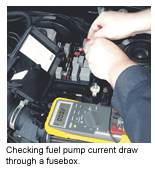 There’s also the components in the fuel system itself: the fuel pump, pump relay, fuel filter, fuel lines, pressure regulator and injectors. Problems with any of these components may prevent fuel from reaching the engine or reaching it at the correct pressure.
There’s also the components in the fuel system itself: the fuel pump, pump relay, fuel filter, fuel lines, pressure regulator and injectors. Problems with any of these components may prevent fuel from reaching the engine or reaching it at the correct pressure.
The point here is a lot of things can affect the operation of the fuel delivery system. The challenge is to figure out what’s causing the problem without wasting a lot of time chasing dead ends. We don’t have the space to explore every possibility, so we’ll focus on the main components in the fuel system itself.
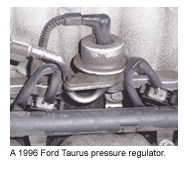 Crank? Yes.Start? No
Crank? Yes.Start? No
Where do you begin your diagnosis if you have an engine that cranks, but won’t start? One of the first things you should do is check for spark. Got spark? What about compression? If the engine has a belt-driven cam, make sure the belt hasn’t failed. Also, check for any loose hoses that might be creating a huge vacuum leak.
If ignition and compression are both OK, that leaves fuel as the obvious culprit. Now the question is, what’s wrong with the fuel delivery system?
The most likely causes are:
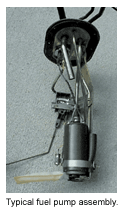
A dead fuel pump (could be the pump, pump relay or wiring circuit);
A plugged fuel filter;
Low fuel pressure (weak pump or restricted line); or
No pulse signal to injectors (bad injector relay or PCM driver circuit).
One of the first things to check is the fuel pump. Does the pump run when the engine is cranking? The pump should make a little noise. No noise would tell you the pump isn’t spinning.
On most vehicles the pump is energized by the PCM via a relay. The pump circuit also may be wired though an oil pressure switch and/or an inertia safety switch that kills the pump in case of an accident. Refer to the wiring diagram to find out what’s involved before jumping to any conclusions.
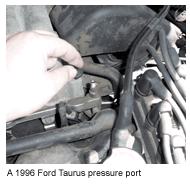 Pressure Building
Pressure Building
Depending on the application, the fuel system may require anywhere from 30 to 80 psi of fuel pressure to start and run. Pressure specifications will vary according to the type of fuel injection system on the engine as well as the performance, fuel economy and emission requirements of that particular model year vehicle. There are no rules of thumb. Every application is different, so always look up the pressure specs when troubleshooting fuel-related performance problems.
When there’s too much fuel pressure, the engine runs rich. This causes an increase in fuel consumption and carbon monoxide (CO) emissions. An engine that’s running really rich also may experience a rough idle, surging and possibly even carbon-fouled spark plugs.
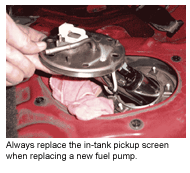 When there isn’t enough fuel pressure, the engine may not start. Or if it does, it may idle roughly and run poorly. Low fuel pressure creates a lean fuel condition that can cause lean misfire, hesitation, rough idle, hesitation and misfire on acceleration.
When there isn’t enough fuel pressure, the engine may not start. Or if it does, it may idle roughly and run poorly. Low fuel pressure creates a lean fuel condition that can cause lean misfire, hesitation, rough idle, hesitation and misfire on acceleration.
Pressure Check
To check fuel pressure, you need a gauge and a place to attach it. There are a number of different checks that can be made, including static or rest pressure (key on, engine off), residual fuel pressure, running pressure, maximum or “dead head” pressure and volume of fuel delivered. The fuel pressure regulator also should be tested, and a fuel pressure drop test performed to check for dirty fuel injectors.
Different vehicle manufacturers recommend different test procedures. On many European EFI systems, the OEMs recommend using a static pressure test with the engine and ignition off. This is done by bypassing the fuel pump relay and energizing the pump directly. Most domestic and Asian vehicle manufacturers, on the other hand, provide a test fitting on the fuel rail so pressure can be checked with the engine running.
If you’re working on a vehicle that does not have a pressure test fitting, you’ll have to tee a pressure gauge into the fuel line just ahead of the injector fuel rail.
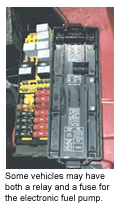 Caution: Before hooking up your pressure gauge, relieve all pressure in the fuel system.
Caution: Before hooking up your pressure gauge, relieve all pressure in the fuel system.
The following are some good diagnostic tests to help you solve a fuel delivery problem.
Bad Pump
If you’ve diagnosed a bad fuel pump and replacement is needed, be sure to inspect the inside of the fuel tank. The presence of rust or debris in the pump’s pickup screen would tell you the tank needs to be cleaned or replaced.
When replacing an in-tank pump, always disconnect the battery to prevent any unwanted sparks. Then drain the tank before removing the tank straps and opening the pump’s retaining collar. When installing the new pump, always replace the in-tank pickup screen and use a new O-ring for the sealing collar.


